Perched high at 1,500 meters above sea level, Quan Ba Heaven Gate stands as the magnificent entrance to Ha Giang’s legendary Dong Van Karst Plateau. This natural wonder marks the boundary between ordinary landscapes and the extraordinary world of limestone formations, terraced fields, and mist-shrouded valleys that have captivated travelers for generations. As the first major landmark on the famed Ha Giang Loop, Quan Ba Heaven Gate offers visitors not just breathtaking panoramic views but also a glimpse into the rich cultural tapestry and mystical legends that define northern Vietnam’s remote highlands.
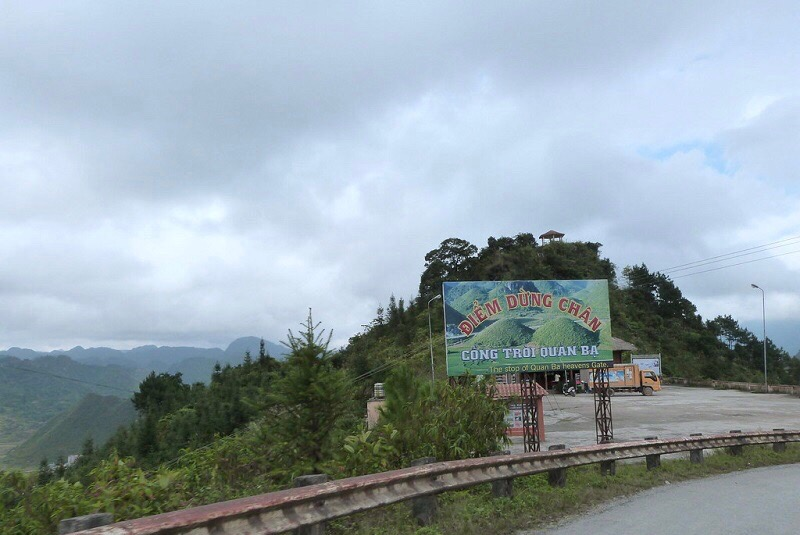
1. What Is Quan Ba Heaven Gate?
Standing at the gateway between the valleys and the rocky highlands, Quan Ba Heaven Gate serves as both a geographical marker and a cultural symbol. This natural pass represents the gateway to Vietnam’s most spectacular karst plateau and introduces travelers to the breathtaking beauty that awaits along the famed Ha Giang Loop.
1.1 Location and Elevation
Quan Ba Heaven Gate is situated in Quan Ba District of Ha Giang Province, approximately 43 kilometers north of Ha Giang City along National Highway 4C (also known as “Happiness Road”). Nestled at an impressive altitude of 1,500 meters above sea level, it marks the official entrance to the UNESCO-recognized Dong Van Karst Plateau Geopark.
The strategic position of Heaven’s Gate makes it the first major scenic highlight for travelers embarking on the Ha Giang Loop journey. From this elevated vantage point, visitors can witness the dramatic transition from the gentler landscapes of lower Ha Giang to the rugged limestone formations that characterize the plateau region.
1.2 Historical Overview: From French Colonial Outpost to Scenic Icon
The history of Quan Ba Heaven Gate intertwines with Vietnam’s complex past. During the French colonial period in the early 20th century (before 1945), the French established a wooden gate and checkpoint at this strategic mountain pass to control movement between regions. Though the original wooden structure no longer exists, the location retained its significance as a boundary marker.
After the construction of Highway 4C between 1959 and 1965 a monumental feat accomplished largely by hand through the efforts of youth volunteers Quan Ba Heaven Gate became more accessible. This engineering marvel, often called the “Happiness Road,” connected previously isolated mountain communities and eventually transformed the gate from a military checkpoint into a celebrated tourist destination.
Today, Quan Ba Heaven Gate stands as a testament to both natural grandeur and human perseverance. Modern infrastructure developments have made this once-remote outpost accessible to travelers seeking to experience the untamed beauty of Ha Giang’s highlands while preserving its historical significance as the threshold to one of Vietnam’s most distinctive geological landscapes.
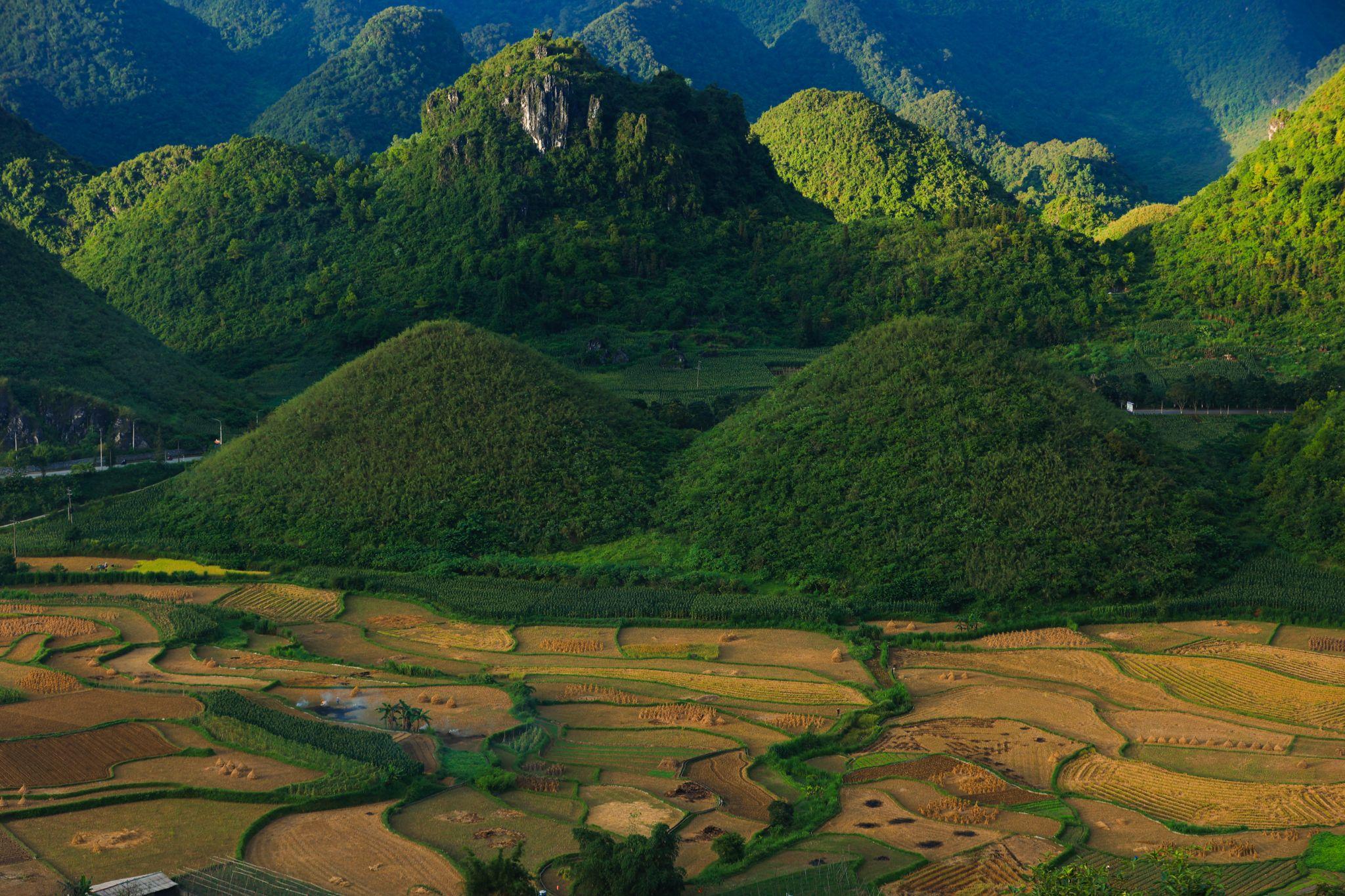
Quan Ba Twin Mountains: Ha Giang’s Iconic Fairy Hills and Complete Travel Guide
2. Why Is Quan Ba Heaven Gate Famous?
Quan Ba Heaven Gate has earned its reputation as a must-visit destination through a perfect combination of natural splendor, cultural significance, and mythical allure. Its fame extends beyond mere scenic beauty to encompass stories and geological features that have captured the imagination of visitors for generations.
2.1 The Legend and Mystery of Quan Ba Twin Mountains (Fairy Bosom)
Perhaps the most iconic feature visible from Quan Ba Heaven Gate is the pair of perfectly rounded hills rising from the valley floor below. Known locally as “Nui Doi” (Twin Mountains) or more poetically as “Fairy Bosom” (Núi Đôi Cô Tiên), these distinctive formations are the subject of one of Ha Giang’s most beloved legends.
2.1.1 Geology and Folklore: Fairy, Motherhood, and Myth
Geologically, the Twin Mountains are formed from karst limestone that has weathered over millions of years into their current distinctive shape. Scientists explain their unusual rounded form as the result of specific erosion patterns in the dolomite rock common to this region.
However, local Hmong folklore offers a more enchanting explanation. According to legend, a beautiful mountain fairy fell in love with a human flute player whose melodies reached heaven itself. When she descended to Earth to be with him, they had a child together. Unable to return to heaven with her baby, yet forbidden from staying on Earth, the fairy was forced to leave her child behind. As a final act of love, she left behind her bosom, transformed into two perfectly rounded hills, to nourish her child forever.
This poignant tale of maternal sacrifice resonates deeply in Vietnamese culture, where the Twin Mountains symbolize motherhood, fertility, and the nurturing aspects of the natural world. For many visitors, witnessing these formations connects them to both the geological wonder and cultural heritage of the region.
2.2 Breathtaking Landscapes and Terraced Fields
Beyond the Twin Mountains, Quan Ba Heaven Gate provides an unparalleled panoramic view of Ha Giang’s diverse landscape. From this elevated position, visitors can gaze across a seemingly endless expanse of jagged limestone peaks, verdant valleys, and intricately terraced rice fields that change colors with the seasons.
The vista from Heaven’s Gate reveals the harmony between natural formations and human cultivation. Terraced fields, meticulously carved into steep hillsides by generations of ethnic minority farmers, create a living patchwork that shifts from vibrant green in spring to golden yellow during harvest season. These agricultural masterpieces demonstrate the remarkable adaptation of local communities to the challenging mountain environment.
On clear days, the view extends to distant mountain ranges fading into blue haze, while misty mornings transform the landscape into an ethereal sea of clouds with peaks emerging like islands. This ever-changing scenery ensures that no two visits to Quan Ba Heaven Gate are exactly alike, making it a photographer’s paradise and a meditative space for travelers seeking connection with nature’s grandeur.
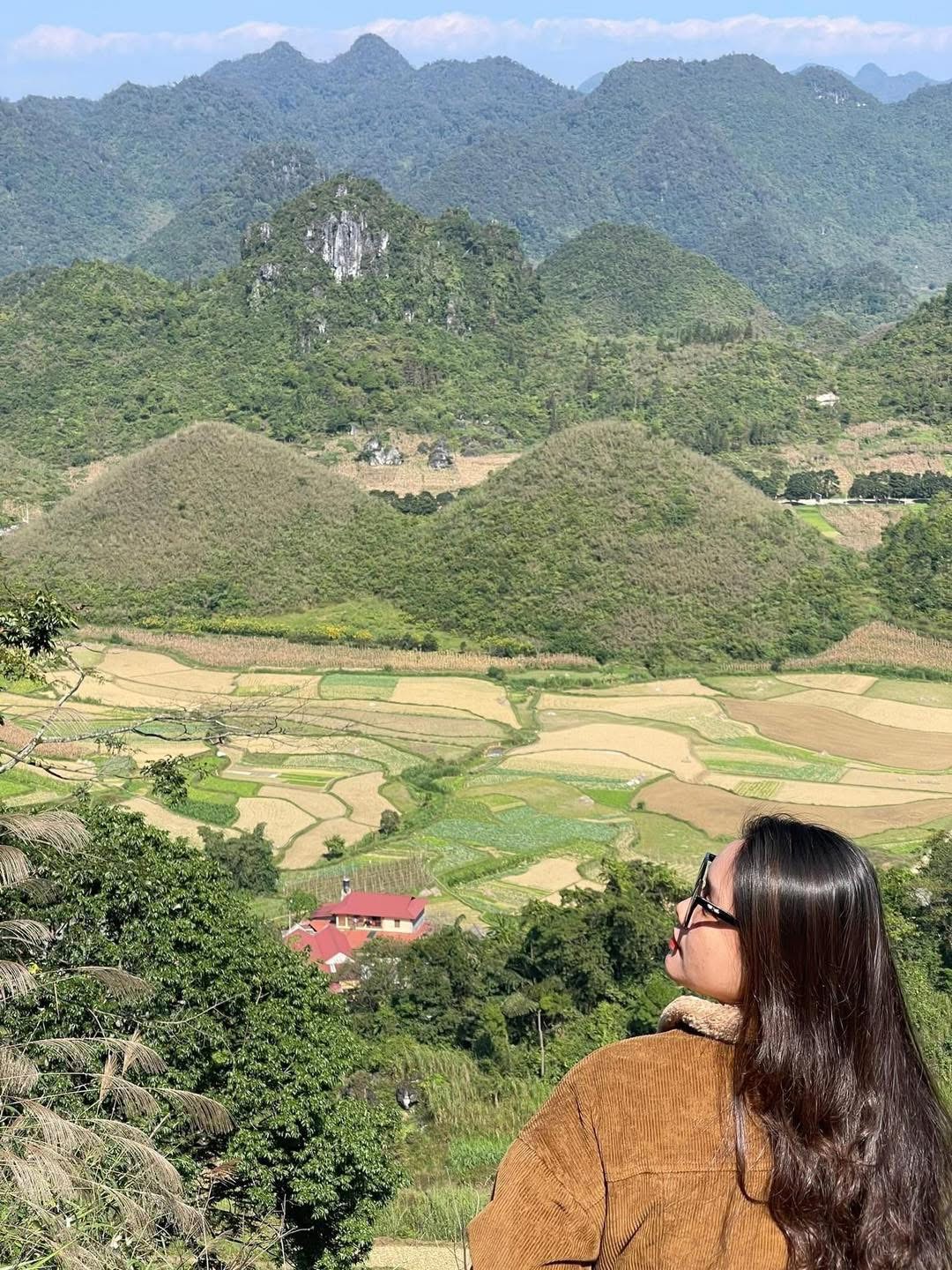
Beyond the Beaten Path: Discovering Ha Giang Province in Northeast Vietnam
3. How to Get to Quan Ba Heaven Gate
Reaching Quan Ba Heaven Gate is part of the adventure, involving a journey through some of northern Vietnam’s most spectacular mountain roads. While the route requires careful navigation, the reward of experiencing this magnificent gateway makes every twist and turn worthwhile.
3.1 Transport Options From Ha Giang City
Most journeys to Quan Ba Heaven Gate begin in Ha Giang City, the provincial capital and main transportation hub for the region. From Ha Giang, several options are available for the 43-kilometer journey to Heaven’s Gate:
- Motorbike rental: The most popular and flexible option, allowing you to stop freely along the route. Standard semi-automatic bikes cost between 150,000-250,000 VND per day, while more powerful models are available for 300,000-500,000 VND. A valid license and riding experience are highly recommended due to the winding mountain roads.
- Easy Rider services: For those uncomfortable driving themselves, local guides offer “Easy Rider” services where experienced drivers transport you by motorcycle. Prices typically range from 500,000-700,000 VND per day including fuel, and provide the added benefit of local knowledge and interpretation.
- Private car hire: A more comfortable but pricier option at approximately 1,000,000-1,500,000 VND per day. This option is suitable for families or those preferring shelter from the elements.
- Group tours: Various tour operators in Ha Giang offer day trips or multi-day expeditions that include Quan Ba Heaven Gate. These typically cost 250,000-400,000 VND per person for day tours or are included in comprehensive Ha Giang Loop packages.
The journey along Highway 4C takes approximately 1.5-2 hours, depending on road conditions and how frequently you stop to admire the increasingly dramatic scenery.
3.2 Safety Tips for Mountain Travel
The route to Quan Ba Heaven Gate traverses challenging mountain terrain and requires appropriate preparation:
- Weather awareness: Check forecasts before departing, as fog, rain, or landslides can affect road conditions. The route is most dangerous during the rainy season (May-September).
- Start early: Begin your journey in the morning to ensure good visibility and allow time for stops along the way. This also helps avoid reaching Heaven’s Gate during midday when clouds often obscure the view.
- Proper equipment: If traveling by motorbike, wear a helmet, closed shoes, and weather-appropriate clothing. Temperatures at Heaven’s Gate can be significantly cooler than in Ha Giang City, especially in winter months.
- Vehicle maintenance: Ensure your vehicle is in good condition before departure. Fuel stations are available in Ha Giang City and Tam Son town, but limited in between.
- Stay connected: Download offline maps and inform someone of your itinerary. Cell service can be spotty along certain stretches of the route.
- Take it slow: The road features numerous sharp curves and occasional steep inclines. Drive at a comfortable pace, especially when encountering large vehicles on narrow sections.
Following these precautions will help ensure your journey to Quan Ba Heaven Gate remains safe and enjoyable, allowing you to fully appreciate the spectacular approach to this natural wonder.
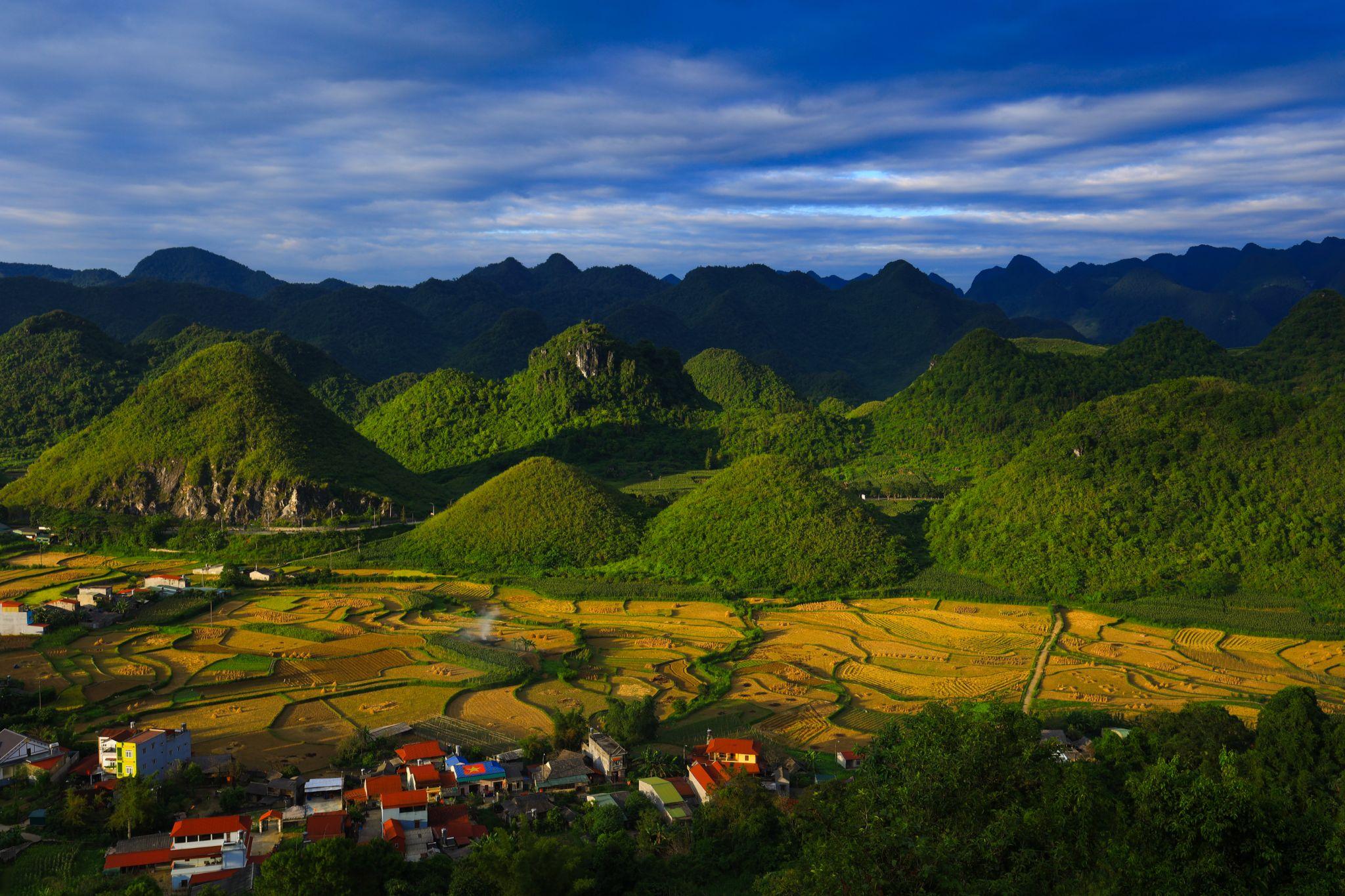
4. Top Things to Do at Quan Ba Heaven Gate
Quan Ba Heaven Gate offers more than just a momentary stop on the Ha Giang Loop – it’s a destination worth exploring in its own right. From photography to cultural immersion, visitors will find numerous ways to connect with this remarkable landscape.
4.1 Best Viewpoints and Photo Opportunities
Photographers and scenery enthusiasts will find multiple vantage points around Quan Ba Heaven Gate that showcase different aspects of the breathtaking landscape:
- The main observation deck: Located directly adjacent to the highway, this official viewing platform offers the classic panoramic vista of the valley below, including the famous Twin Mountains. It features stone benches and informational plaques explaining the geological and cultural significance of the area.
- Heaven’s Gate Café: Situated slightly higher than the main platform, this café provides similar views with the comfort of seating, refreshments, and shelter from sun or rain. The wooden deck extends out for unobstructed photography.
- Northern ridge trail: A short walking path heading north from the main area leads to less crowded viewpoints that frame the Twin Mountains from different angles, especially beautiful in morning light.
- Skywalk viewpoint: Approximately 500 meters from the main area, this newer viewing platform extends over the valley edge for a more dramatic perspective. While requiring a short walk, it often provides a quieter experience away from tour groups.
For optimal photography, early morning visits (before 9 AM) offer the best lighting and atmospheric conditions. During this time, mist often fills the valley, creating dreamlike compositions as it swirls around the limestone formations and gradually reveals the landscape below.
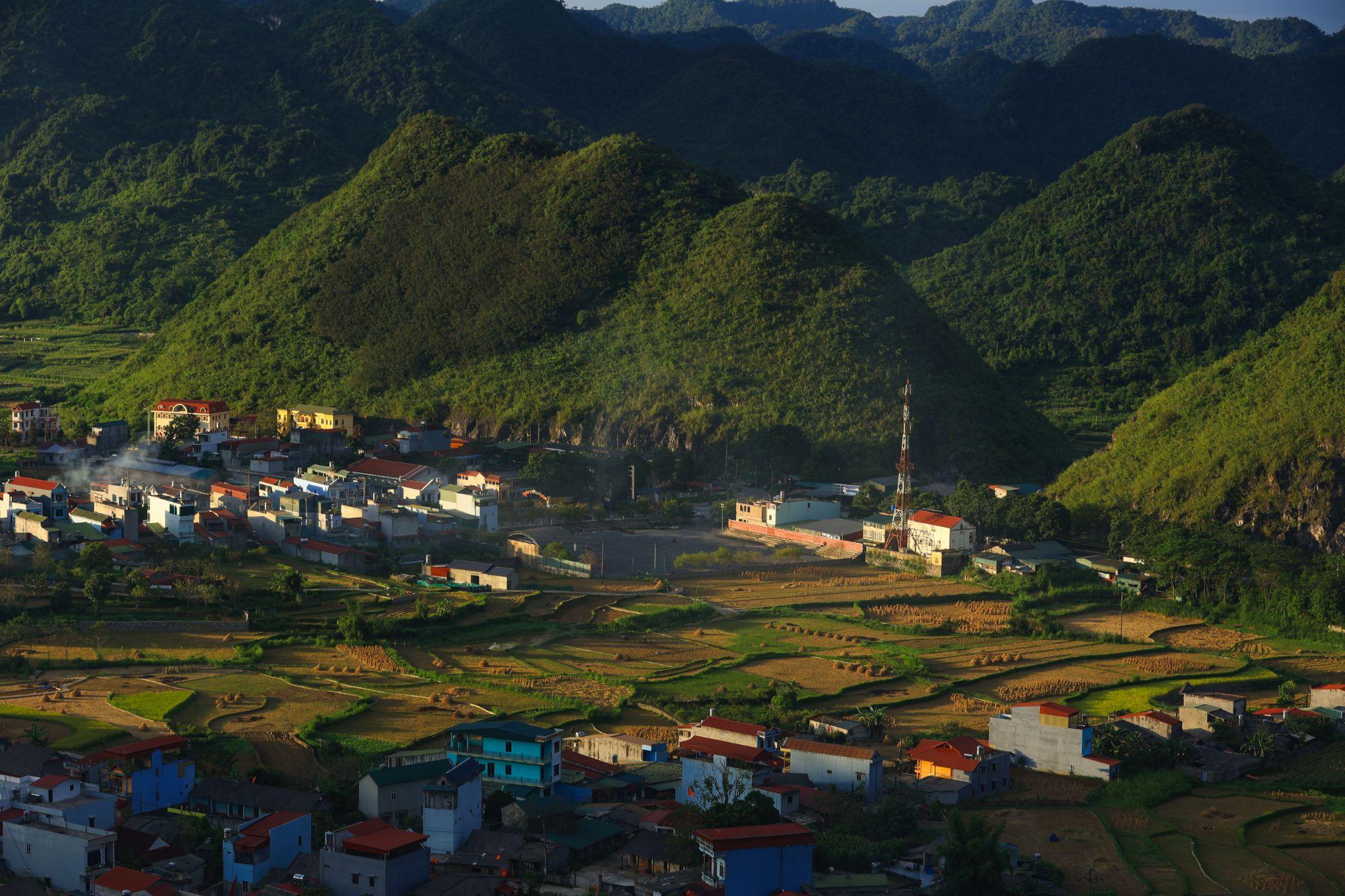
4.2 Trekking Routes and Outdoor Activities
For active travelers, Quan Ba Heaven Gate serves as an excellent starting point for exploring the surrounding highlands:
- Twin Mountains circuit: A moderate 5-7 km trek descends from Heaven’s Gate into the valley, circling around the base of the Twin Mountains. This route passes through small ethnic minority villages and agricultural areas, offering close-up perspectives of the iconic formations.
- Tam Son town exploration: About 5 km from Heaven’s Gate, Tam Son (the district capital) offers additional cultural experiences, a Sunday market, and connections to other local hiking trails.
- Nam Dam village trek: This 10 km route from Heaven’s Gate leads to a well-preserved Dao ethnic village known for its traditional architecture and sustainable tourism initiatives.
- Mountain biking: Several outfitters in Tam Son offer mountain bike rentals for exploring the network of dirt roads and trails that branch off from the main highway near Heaven’s Gate.
These activities allow visitors to experience the landscape more intimately than simply viewing it from the roadside. However, independent trekkers should carry detailed maps or arrange local guides, as trails are often unmarked and weather conditions can change rapidly in the mountains.
4.3 Exploring Local Ethnic Culture
Quan Ba district is home to diverse ethnic minority communities, particularly Hmong, Dao, and Tay peoples, each with distinct traditions, crafts, and agricultural practices:
- Local markets: Tam Son hosts a vibrant Sunday market where ethnic minorities gather to trade goods, socialize, and showcase traditional attire. Even on non-market days, smaller local markets operate regularly.
- Homestay experiences: Several nearby villages offer authentic homestays with local families, providing opportunities to participate in daily activities like cooking, farming, or textile production.
- Cultural performances: During major holidays and festivals, traditional music and dance performances sometimes take place near Heaven’s Gate or in Tam Son town. The local tourism office can provide updated schedules.
- Craft demonstrations: In some villages, artisans demonstrate traditional skills like embroidery, weaving, or blacksmithing, often selling handmade souvenirs that support local economies.
Engaging respectfully with these communities offers insights into how the highland peoples have adapted to and shaped the dramatic landscape visible from Quan Ba Heaven Gate. Remember to ask permission before photographing local residents, especially during non-touristic activities, and consider purchasing handicrafts as a way to support traditional livelihoods.
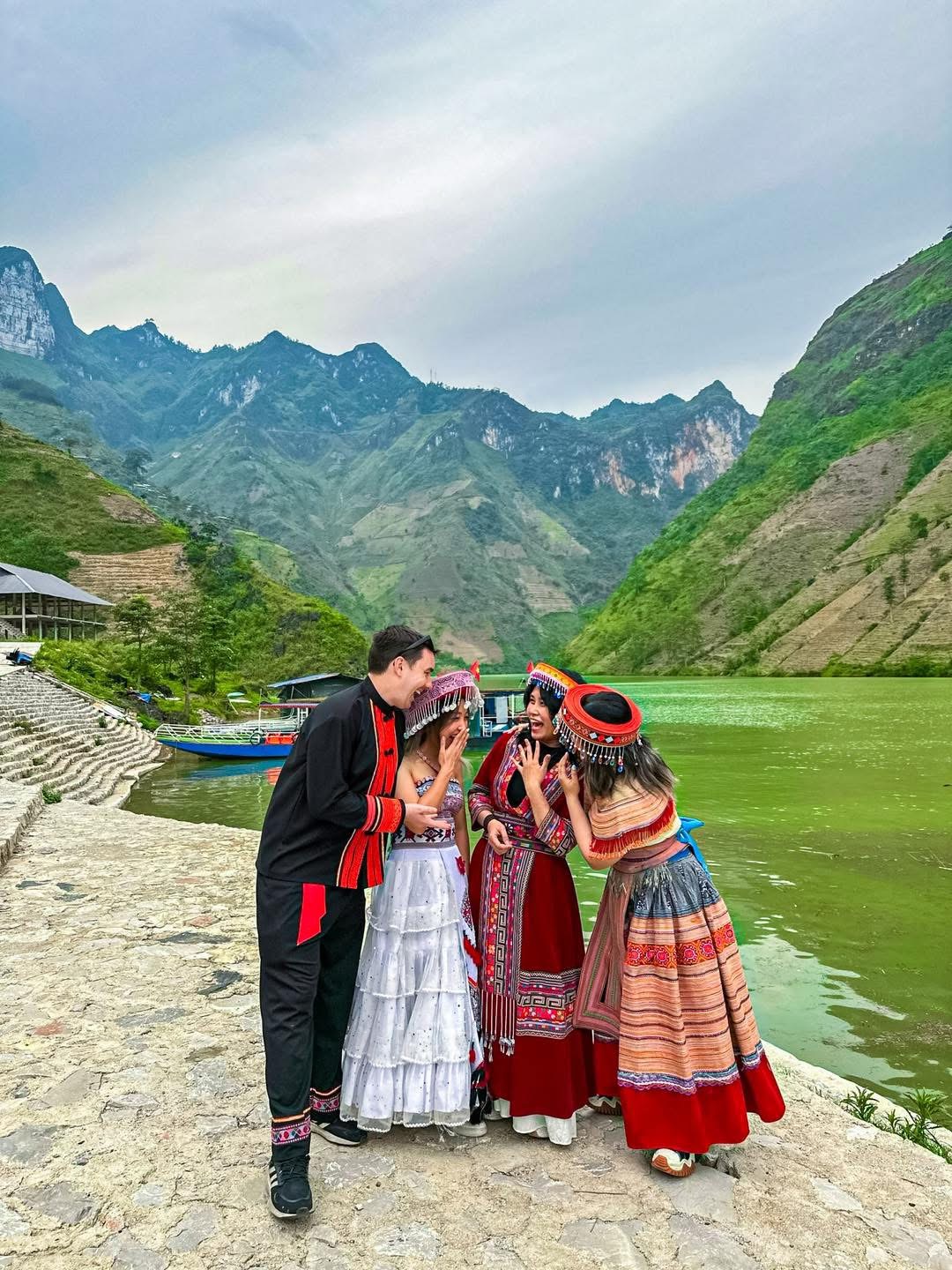
Brocade Clothes in Ha Giang: 6 Ethnic Styles You Should Know
5. When Is the Best Time to Visit Quan Ba Heaven Gate?
Timing your visit to Quan Ba Heaven Gate significantly impacts the experience. Each season transforms the landscape with different colors, weather patterns, and cultural activities that highlight various aspects of this magnificent gateway.
5.1 Beauty in Rice Season (August–October)
Late summer through early autumn marks the most visually spectacular time to experience Quan Ba Heaven Gate. During these months, several elements combine to create the region’s most iconic scenes:
- Golden terraced fields: By late August, rice paddies that cascade down the valley slopes begin turning from vibrant green to rich gold. This creates a stunning contrast against the grey limestone formations and the deep green of surrounding forests. By September, the entire landscape glows with warm amber tones.
- Optimal weather conditions: This period typically brings clear skies and moderate temperatures, ranging from 15-25°C (59-77°F). Morning fog often creates atmospheric conditions that gradually clear to reveal spectacular vistas, perfect for photography.
- Harvest activities: Local farmers busy with traditional harvesting methods add cultural interest to the landscape. The terraced fields become hives of activity as communities work together to gather their crops.
- Buckwheat flowers: In late September through October, pink and purple buckwheat blooms blanket certain fields visible from Heaven’s Gate, adding another dimension of color to the already spectacular scenery.
During this peak season, Quan Ba Heaven Gate attracts more visitors, especially on weekends. For a more peaceful experience, plan to arrive early in the morning (before 8 AM) or opt for a weekday visit.
5.2 Spring Festivals and Wildflowers (February–April)
Spring offers a completely different but equally compelling experience at Quan Ba Heaven Gate, characterized by cultural celebrations and the reawakening of the natural landscape:
- Ethnic festivals: The period following Tet (Vietnamese New Year, typically falling in February) features numerous traditional celebrations among the Hmong, Dao, and other ethnic groups. These include the Gau Tao festival (Hmong New Year), plum flower celebrations, and various spring rituals marking the agricultural calendar.
- Blooming season: By March and April, mountainsides visible from Heaven’s Gate burst with wildflowers and fruit tree blossoms. Peach, plum, and apricot flowers create splashes of pink and white against the emerging green of new rice plantings.
- Vivid green landscapes: Spring rice planting transforms the terraced fields into glistening mirrors of water, later giving way to the intense emerald green of young rice plants. This creates a striking contrast with the stark limestone formations.
- Pleasant temperatures: Daytime temperatures typically range from 12-22°C (54-72°F), ideal for trekking and outdoor exploration. However, spring can bring occasional mist and light rain, adding a mystical quality to the views while sometimes temporarily obscuring distant vistas.
Spring visits offer fewer crowds than the peak autumn season, allowing for a more contemplative experience of Quan Ba Heaven Gate. The renewal of the natural world during this season perfectly complements the gateway’s symbolic role as a threshold to new experiences.
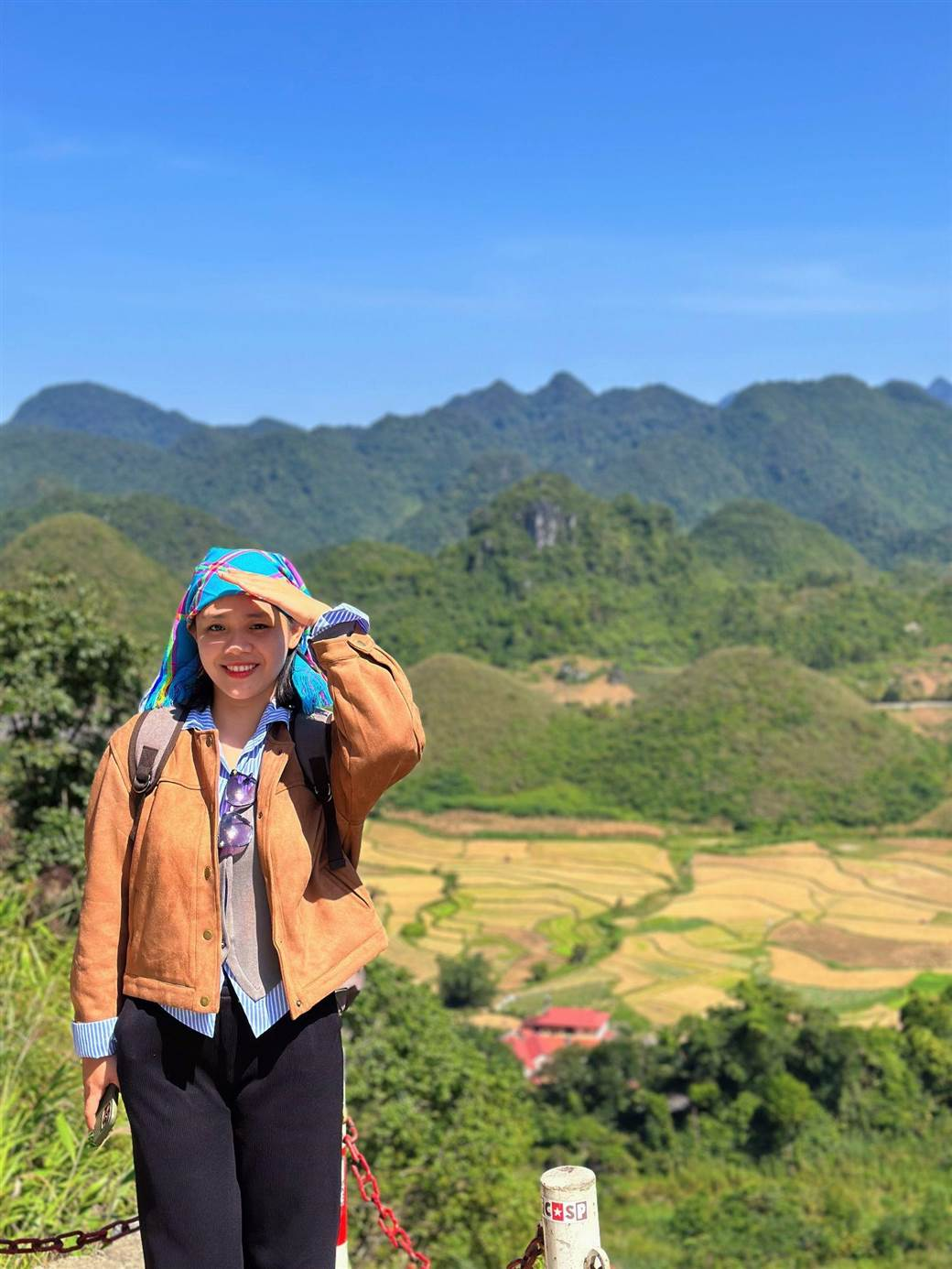
The Best Time to Visit Ha Giang: A Seasonal Guide to Flowers & Festivals
6. Travel Tips and FAQs for Visitors
Preparing properly for your visit to Quan Ba Heaven Gate enhances both enjoyment and safety. These practical tips and answers to common questions will help you plan a smooth experience at this remarkable destination.
6.1 What to Pack and Prepare
The mountain environment around Quan Ba Heaven Gate requires specific preparation:
- Layered clothing: Temperatures can vary significantly throughout the day, particularly between sunny and shaded areas. Pack lightweight, moisture-wicking layers that can be added or removed easily. Even in summer, bring a light jacket for mornings and evenings.
- Sun protection: The high elevation means increased UV exposure, even on cloudy days. Bring sunscreen, sunglasses, and a hat with a brim.
- Proper footwear: If you plan to explore beyond the main viewing platform, wear sturdy shoes with good traction. Trails can be steep and sometimes muddy or slippery.
- Rain gear: Mountain weather can change quickly. A lightweight raincoat or poncho takes little space but proves invaluable during unexpected showers.
- Camera equipment: The sweeping vistas call for wide-angle lenses. If possible, bring a polarizing filter to reduce haze and enhance the vibrant colors of the landscape. Extra batteries are recommended as charging opportunities may be limited.
- Cash: Few establishments around Quan Ba Heaven Gate accept cards, and ATMs are scarce outside Ha Giang City. Bring sufficient cash in small denominations for entrance fees, refreshments, and souvenirs.
- Snacks and water: While there are small cafés near the main viewpoint, bringing your own water and energy-boosting snacks is advisable, especially if you plan to trek or explore beyond the immediate area.
6.2 Essential Contacts and Local Facilities
Having key information handy can prove invaluable in this remote region:
- Emergency services: Program the national emergency number (113 for police, 115 for ambulance) into your phone, though service may be limited in remote areas.
- Phieu travel (A local tour operator in Ha Giang): 0799061111 – can provide updated information on road conditions and local events.
- Tam Son Medical Center: Located approximately 5 km from Heaven’s Gate, this basic facility can handle minor medical issues.
- Accommodation options: While most visitors don’t stay directly at Heaven’s Gate, nearby Tam Son town offers several guesthouses and homestays, including Dao Lodge, Tam Son Hostel, and Nam Dam Homestay Village.
- Local guides: For deeper exploration, consider hiring a local guide through the Ha Giang Tourism Office or reputable tour operators in Ha Giang City. Local guides typically charge 300,000-500,000 VND per day and provide invaluable cultural and historical context.
- Food and refreshments: Small cafés and food stalls near the viewing platform offer Vietnamese coffee, tea, and simple local dishes. For more substantial meals, Tam Son town provides additional options featuring regional specialties.
Keeping this practical information accessible ensures you can focus on enjoying the magnificent landscapes and cultural experiences that make Quan Ba Heaven Gate one of northern Vietnam’s most treasured destinations.
Quan Ba Heaven Gate stands as both a physical gateway to Vietnam’s most spectacular highland terrain and a symbolic threshold to unforgettable experiences. From its commanding position 1,500 meters above sea level, this natural wonder offers visitors their first glimpse into the extraordinary world of Ha Giang’s limestone formations, terraced fields, and ethnic diversity. Whether you’re captivated by the mythical Twin Mountains, the ever-changing seasonal landscapes, or the rich cultural tapestry of the region’s ethnic minorities, Heaven’s Gate provides the perfect introduction to northern Vietnam’s most pristine frontier.
As you plan your journey to this remarkable destination, remember that timing your visit to align with the golden rice harvest or the vibrant spring renewal can dramatically enhance your experience. The winding mountain road that leads to this heavenly viewpoint may challenge travelers, but the reward of standing at this lofty gateway – where clouds meet mountains and legends touch reality – creates memories that endure long after returning home.
For assistance planning your trip to Quan Ba Heaven Gate and other highlights of the legendary Ha Giang Loop, visit Phieutravel.com for trusted guidance, transportation options, and authentic local experiences. Our expert team specializes in helping travelers discover the perfect balance between iconic destinations like Quan Ba Heaven Gate and hidden gems that reveal the true spirit of Ha Giang’s mystical highlands.
Read more:
- Bac Sum Pass Gateway to Ha Giang Loop Adventure
- Explore Lao Xa Village: Hmong Life on Dong Van Plateau
- The Ultimate Guide to Driving the Ha Giang Loop by Car from Hanoi

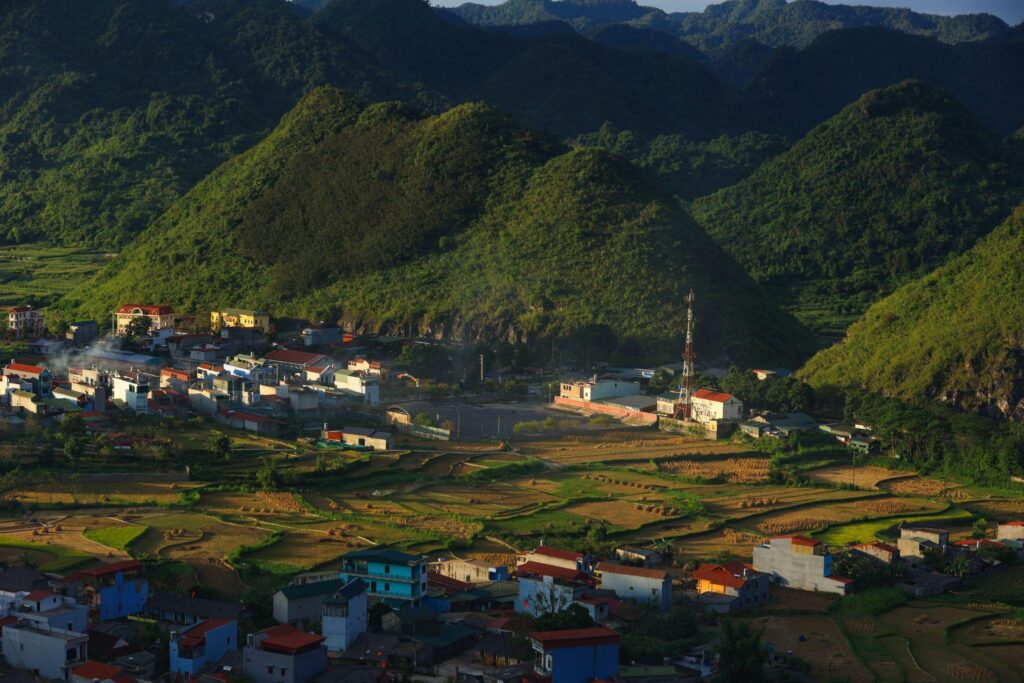
You Might Also Like
Ha Giang Weather in September: Complete Guide for Travelers
Exploring the magnificent Ha Giang Loop in September offers travelers a perfect balance of favorable[...]
Quan Ba Twin Mountains: Ha Giang’s Iconic Fairy Hills and Complete Travel Guide
The mystical Quan Ba Twin Mountains rise from the emerald valleys of Ha Giang like[...]
Vuong family mansion: the architectural marvel and cultural legacy of Ha Giang
Deep in Vietnam’s northern highlands, where mist-shrouded mountains meet terraced rice fields, stands a testament[...]
Ha Giang Loop Safety Tips: How to Ride Securely in Vietnam’s Northern Mountains
The Ha Giang Loop, with its winding mountain roads and breathtaking landscapes, offers one of[...]
The Ultimate Guide to the M-Shaped Curve on Ha Giang Loop
Vietnam’s remote northern province of Ha Giang hides a natural wonder that has captivated adventurous[...]
Most Beautiful Places to Visit in Vietnam: Essential Destinations and Insider Tips
Vietnam captivates travelers with its stunning landscapes, rich cultural heritage, and warm hospitality. From mist-shrouded[...]
Beyond the Beaten Path: Discovering Ha Giang Province in Northeast Vietnam
Ha Giang Province in Northeast Vietnam stands as one of the country’s last frontiers for[...]
Rainy season in Ha Giang: what to expect, when to go, and travel tips
Vietnam’s northern frontier reveals a different face during the rainy season, transforming Ha Giang’s limestone[...]